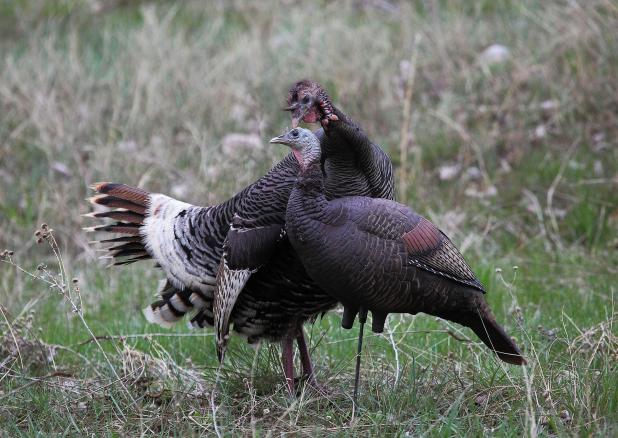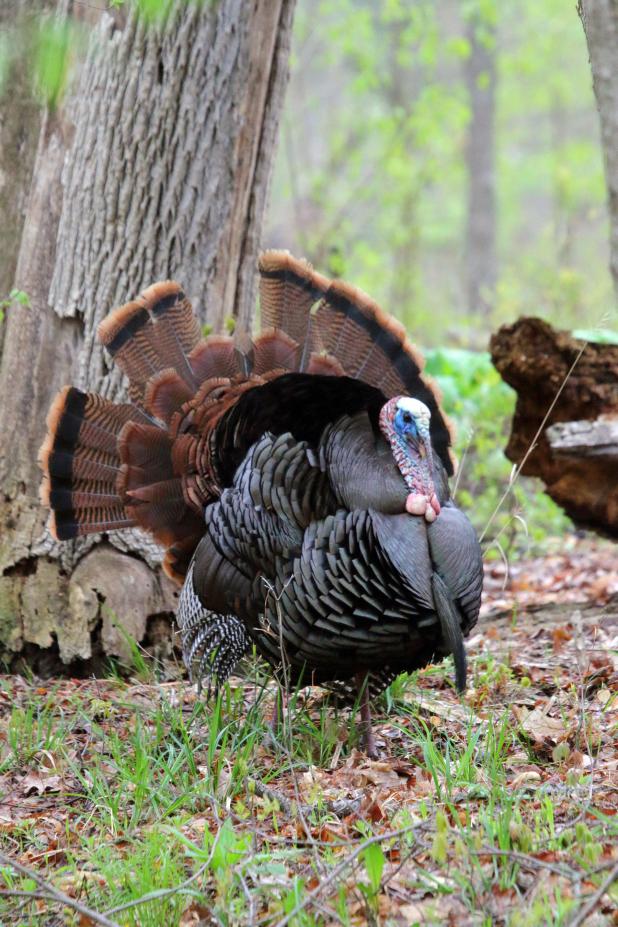
This Merriam subspecies hen turkey pecks a decoy the author put out while hunting the Black Hills of South Dakota.
The Review/John K. Flores

This eastern turkey gobbler struts trying to attract a hen.
John K. Flores: Let's talk turkey; La. season opens Saturday
About a decade ago I came across a magazine ad with a hook that read, “Gobblers and Gardenias.” Curious, I called the number.
The ad was placed by the then owners of the Briar’s Plantation in Natchez, Mississippi. For $1,200 you received a two-night stay, with breakfast, lunch and dinner, but here’s where it got better.
Two guided morning turkey hunts were included in the price and while the guys were off hunting, the spouse on one of the two days received a massage in her room.
Needless to say, it wasn’t a difficult sell to my wife. I booked the trip for opening weekend of the Mississippi spring turkey season.
A few weeks later I found myself sitting in the dark with my guide underneath some dogwood trees waiting for daylight. I was in my late 50s then, and never hunted turkeys before. Over the years, it was something I always wanted to do, but just never got around to doing.
The air was cool and the quiet woods a refreshing departure from the hustle and bustle of working in a fabrication yard next to railroad tracks.
Suddenly, the woods erupted with the sound of a gobble. In the twilight, the big gobbler had flown down from his roost and was putting any interlopers on notice the local flock of hens were his and his only.
The sound raised the hairs on the back of my neck and got my heart pumping. “So, this is what turkey hunting is like,” I thought to myself.
My guide, Leon Atkins, took a slate call and striker out of his pocket and made a few soft yelps with it, mimicking a hen turkey. The gobbler instantly responded with a gobble.
Atkins and the gobbler exchanged addresses for several minutes and each time the gobbler responded he came a little closer. When he came close enough to shoot, I was too anxious and missed the bird completely.
My chin dropped to my chest and rested there for a few seconds, when Atkins encouragingly said, “Let’s go get another one.”
We walked a half mile or so and set up under a cherry bark oak tree. This time we put out a couple of hen decoys. When we got settled in, once again Atkins made a few soft calls.
This time, we didn’t get a response. It didn’t matter, because in short order a gobbler came up the hill we were watching, and I was ready. It walked right up to the decoys, and I shot.
As it turned out, Atkins was a turkey-hunting fanatic. He had hunted turkey all across the Southeast, upper Midwest, and Southwest killing what is known as the “grand slam” several times and in the same year.
The grand slam is made up of four sub-species of turkeys in North America, the eastern, the Merriam, the Osceola, and the Rio Grande. There is a fifth U.S. species, known as the Goulds that is found in Arizona, New Mexico and northern Mexico. At the present their population numbers aren’t sufficient to hold a limited season.
It was Atkins who infected me with the notion to chase the turkey grand slam saying it’s really something I should do. At the present, I’ve harvested two of the four species and one hybrid Rio-Grande-eastern cross that doesn’t count. And, though I’ve hunted Merriams in Nebraska, South Dakota and New Mexico, I’ve not closed the deal on this sub-species.
According to the Louisiana Department of Wildlife and Fisheries website, prior to 1880 the Louisiana population of wild turkeys was estimated at 1 million birds. However, due to forest exploitation the population dwindled to 1,500 by World War II.
In 1962 the LDWF and National Wild Turkey Federation partnered and have restocked some 3,900 turkeys in 45 parishes. Now, it is estimated there are 20,000 hunters who pursue turkeys each spring. What’s more, there is plenty of public land available to hunters throughout the state.
Some Wildlife Management Areas require hunters to take part in a general pre-application lottery drawing and others do not.
There are Military reservations like Esler Field (formerly Camp Beauregard) and Fort Johnson-Vernon WMA (formerly Fort Polk-Vernon) that hold open turkey seasons. There’s also Fort Johnson (formerly Peason Ridge).
The state of Louisiana is divided into three turkey hunting zones listed as areas A, B and C, all with varying season dates starting Saturday. Depending on what area you hunt will determine how long you have to hunt.
Kisatchie National Forest is in hunt area “A” and its season runs Saturday through May 5.
For a complete guide to available public lands be sure to go to the LDWF website and review season and WMA regulations.
John Flores is the Morgan City Review’s outdoor writer. He can be contacted at gowiththeflo@cox.net.
